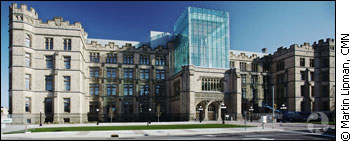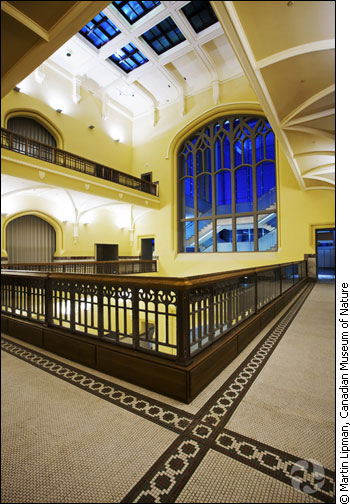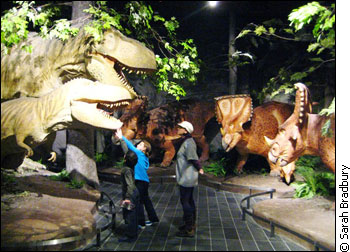Tags
Related Posts
Share This
The rebirth of Nature

The renovated Canadian Museum of Nature with its new glass addition, dubbed the Queen’s Lantern.
The Canadian Museum of Nature is unrecognizable. The scaffolding has been dismantled, revealing the Tudor-Gothic–style Victoria Memorial Building underneath; the construction vehicles and construction workers have departed; and a new glass enclosure housing a staircase, dubbed as the “Queen’s Lantern,” graces the front entrance, evoking the building’s early tower (which was removed in 1916 because unstable soil conditions couldn’t support its weight).
The dust has finally settled—literally—as the extensive six-year-long renovations were completed in 2010. And the timing couldn’t have been better. The year 2010 marked the 100th anniversary of the national historic site and was pegged as the year for bio-diversity. May 22, 2010, the day the museum was unveiled for its grand re-opening, was International Bio-Diversity Day. And on June 30, Her Majesty Queen Elizabeth II and His Royal Highness the Duke of Edinburgh paid a royal visit.
‘It was a large-scale project; it took six years and was the whole building: infrastructure, heritage elements, and new exhibits. It affected every level of the museum.’ – Dan Smythe
“We made it!” says Dan Smythe, the senior media relations officer for the museum. “Looking back at the time, effort and resources it took: It’s finally done.”
Between the grand re-opening and Labour Day weekend, the museum received a record 300,000 visitors. That’s more than the number of visitors the museum saw pre-renovation—annually. Before the renovation, the average number of visitors was between 250,000 and 280,000 per year. By March 2011, the museum will see close to half a million visitors, says Marie Lasnier, director of community services.
Smythe and Lasnier both ascribe the sky-high numbers to the novelty of a re-modelled museum. The years of renovations have created a buzz of anticipation and visitors are excited to rediscover their favourite exhibits, updated and modernized, Smythe says. The renovations allowed for each gallery to be completely re-designed. Every exhibit had to be meticulously taken down. Then, the space was gutted, and re-built from the ground, up. Every gallery had to be re-done, and some galleries—like the RBC Blue Water Gallery—are brand new additions to the museum. The museum also boasts better visitor amenities, like a refurbished boutique and Nature Café.

The renovation included restoration of heritage elements, like mosaic floors and wood banisters.
“The entire building is more flexible,” says Lasnier. “The new facility provides more space and opportunity than it did before.”
However, despite summer’s intoxicating numbers of visitors, Lasnier points out a trend that could have the museum looking at a ten per cent drop next year: She says that after major museums undergo massive renovations (think of the 2007 Michael Lee-Chin Crystal addition to Toronto’s Royal Ontario Museum) and the initial excitement has worn off, the visitor numbers tend to decline.
In an attempt to counteract this decline, or at least slow it down, the museum is coming up with specialty programming to spark more consistent interest. Group tours, monthly programming, and travelling exhibits are some of what the newly-renovated museum can now offer. The museum showed off its new user-friendly floor plan (and its Halloween spirit) this October with haunted tours put on by the Haunted Walk of Ottawa. Around 4,500 people took part in the tours, a number the pre-reno building never could have accommodated.
Lasnier adds that in the coming months, the museum will be able to offer limited-time, specialty activities. The haunted tours will resume next October; November will be meet-the-scientist month, when the museum shows off its research side by offering public meet-and-greets with its scientists; December and March are when school children have their vacations, so the museum will have more family-oriented activities; and in February, an adults-only Valentine activity will take place, educating visitors on the science of love and attraction.
Lasnier also gives some advance info on travelling exhibits that will arrive at the museum in the summertime: Next summer will be Extreme Mammals, an exhibit showcasing some strange mammals that roamed the earth after the dinosaurs became extinct. The following summer, visitors can expect a jaw-dropping whale exhibit from New Zealand. One significance of these travelling exhibits is that the museum could never have housed them before.

Life-sized dinosaurs enchant, in the museum’s vivid displays.
“Travelling exhibits didn’t want to come to the museum before because it was dangerous for the specimens,” Lasnier says. What she’s talking about are the temperature and humidity control systems: The outdated building didn’t have sufficient climate control and couldn’t provide a safe environment for its precious artifacts. Pre-reno, the museum was limited to using display cases for items that needed special care. Some items in the museum’s collections were deemed too valuable or rare to be on public display altogether. Lasnier laments the damage done to one of the mammals on display whose fur literally got eaten by micro-organisms.
As a result, part of the museum’s renovation made a point of updating the electrical, hydro, heating and ventilation systems and reinforcing the building’s structure. Lasnier says the renovations have allowed the museum to offer richer exhibits. More than 1,500 items have been brought out of the storerooms and are now able to be put on display. Smythe adds that half of the minerals in the Vale Earth Gallery hadn’t been seen by the public—in the remodelled gallery, there are more than 1,000 rocks and minerals on display. The Bird Gallery, which also received some additions, is now home to approximately 400 specimens.
Other projects included landscaping and the restoration of heritage elements, like stained glass windows, wood doors, and mosaic floors.
“It was a large-scale project; it took six years and it was the whole building: the infrastructure, heritage elements, and new exhibits. It affected every level of the museum,” Smythe says. “The challenge now is to deal with its popularity!”
Front page photo by Martin Lipman, Canadian Museum of Nature





